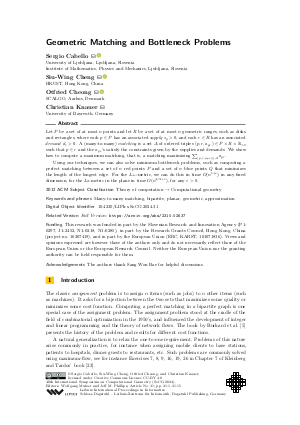LIPIcs.SoCG.2024.31.pdf
- Filesize: 0.93 MB
- 15 pages

 Creative Commons Attribution 4.0 International license
Creative Commons Attribution 4.0 International license

Let P be a set of at most n points and let R be a set of at most n geometric ranges, such as disks and rectangles, where each p ∈ P has an associated supply s_{p} > 0, and each r ∈ R has an associated demand d_r > 0. A (many-to-many) matching is a set 𝒜 of ordered triples (p,r,a_{pr}) ∈ P × R × ℝ_{> 0} such that p ∈ r and the a_{pr}’s satisfy the constraints given by the supplies and demands. We show how to compute a maximum matching, that is, a matching maximizing ∑_{(p,r,a_{pr}) ∈ 𝒜} a_{pr}.
Using our techniques, we can also solve minimum bottleneck problems, such as computing a perfect matching between a set of n red points P and a set of n blue points Q that minimizes the length of the longest edge. For the L_∞-metric, we can do this in time O(n^{1+ε}) in any fixed dimension, for the L₂-metric in the plane in time O(n^{4/3 + ε}), for any ε > 0.








Feedback for Dagstuhl Publishing